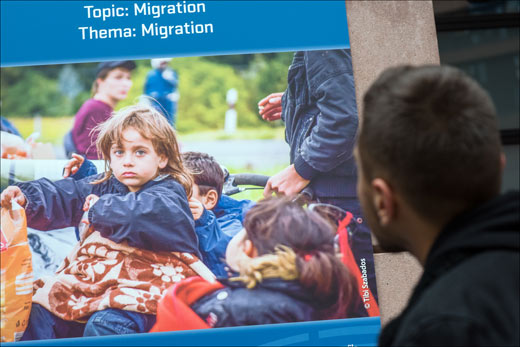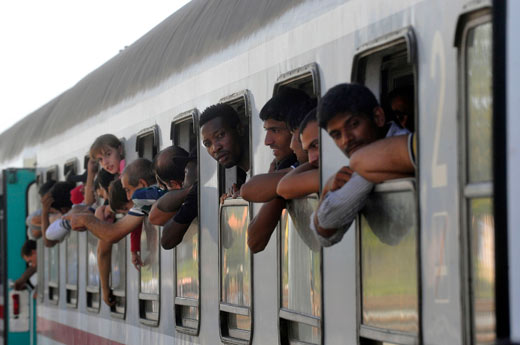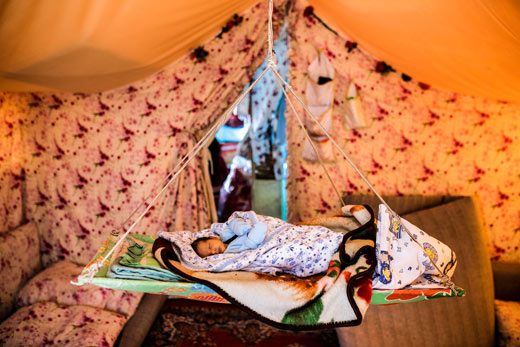ARTICLE
Migrants and refugees: What’s in a name?
The long-standing debate over how to categorise people on the move continues without a resolution in sight, reflecting a broader debate about who is responsible for responding to the plight of refugees and other migrants and what those specific responsibilities are. On the one hand, the category of refugee within the broader context of migration remains a powerful legal tool. On the other, in today’s world of hyper-mobility and dynamic movements of people, the distinctions between forced displacement, voluntary migration with the use of smugglers and trafficked person are often blurred.
This reality of blurred categories, changing labels and complex migration-displacement scenarios is the scene on the ground for many international aid workers. Yet the reality of how international aid operates – from funding to coordination and targeting certain groups – is out of step with this reality. Instead, it is often illogical, wasteful of resources, and can allow for too many people to miss out on much-needed aid, because their experiences do not match strict criteria. At a time when the world is now negotiating separate "compact" deals to better help both migrants and refugees, it is crucial to consider far more clearly how the two categories relate – not to dilute them down, but to strengthen them.
The Global Compact on Refugees[1] and Global Compact for Migration[2] were initially conceived as part of the same global discussion in 2016 and were intended to address inter-related challenges – the need for both protection for refugees and more orderly migration. Yet there has been a lack of co-ordination between them with the result being separate instruments that do not speak to each other. It would seem the two processes have become increasingly siloed, echoing the long-standing debate[3] over how to categorise people on the move.
Duality
In an era of record levels of displacement and shrinking protection space, the specific legal category, refugee, is a crucial tool for targeting and maintaining protection for a specific legal category of people who are living with the realities of a specific set of circumstances. Yet at the same time, realities on the ground demonstrate that refugees have multiple identities, deploy multiple coping strategies, and often defy tidy categories that inevitably fall wide of the mark.

© European Union
‘It is important to remember that human rights are not dependent on migration status, and there can be no exceptions to the rights afforded to people especially while they are in transit.’
Similar things can be said of multiple other categories of migrants moving irregularly, many of whom do not have a ‘category’ to fall into. When both refugees and migrants are on the move together, as in Turkey and Libya, labels and distinctions may matter less at certain times – for instance, when rescuing people at sea – but remain critical when trying to identify people in need of protection from refoulement. Regardless, it is important to remember that human rights are not dependent on migration status, and there can be no exceptions to the rights afforded to people especially while they are in transit. It is also important to recognise that rights violations are prevalent in many migration contexts (including the right to free movement, to liberty, to freedom from torture and many others) whether in a situation of ‘forced’ migration or not.
This duality is reflected in wider debates between those who emphasise the need to maintain a distinctive category of ‘refugee’ within broader policy discussions on migration, and those who assert that these distinctions do not reflect realities on the ground and therefore should either be discarded or changed. For instance, the language of human rights generally, and refugee rights specifically, provides a tool to target national and international policy makers. It ensures an arsenal of international (and often times national) legislation that can back up demands for promoting the rights of refugees. It is often practitioners, who are working specifically within a human rights agenda who recognise that the shrinking space for the protection for refugees makes them a category in need of protection.
Yet the rigidity of categorisation can all too often lead to an over-reliance on policy-driven approaches that are, by nature, a somewhat blunt instrument that fails to interact sufficiently with the context. They fail to function in the grey areas of overlapping legal and social identities, where many of the either/or categories (refugee and returnee; home and exile; migrant and forced migrant) are inadequate in dealing with multiple and multi-faceted realities. It also creates a situation in which individuals and groups can all too easily fall between the cracks because they do not ‘fit’.
Untidy realities of migration
What is needed is a broader approach to protection programmes that acknowledge areas of overlapping responsibilities and obligations – in other words, programmes that recognise the untidy realities of migration. For example, projects should be able to operate in the grey areas of overlapping legal and social identities that challenge many of the binary categories (refugee and returnee; home and exile; migrant and forced migrant; ‘deserving’ and ‘undeserving’) and that address shared needs as well as individual circumstances.

© European Union
Migrants aboard a train at the Croation Beli Manastir station near the Hungarian border, 2015.
Currently there is no single financial tracking system to monitor funding for situations where migrants and refugees are on the move together to ensure that all funds, irrespective of the source, are aligned and meet agreed priorities. This was a key recommendation of outgoing Special Representative of the Secretary-General on Migration Peter Sutherland and his final report to the General Assembly[4], that could be supplemented by coordination at a programmatic level including a mapping of who does what and where through mechanisms such as the Mixed Migration Working Group. This is something the aid community has been doing for a long time in other sectors such as Health and Education, but there are certain operational barriers in the case of the protection of refugees and migrants.
Schism in the aid sector
First, there is a schism in the aid sector itself, which is largely divided between people working on refugees and therefore with a tight and inflexible understanding of who is and is not a part of their mandate, and those working on migration (i.e those on the move except refugees). This is partly due to the fact that refugee issues in the past landed more in the humanitarian basket, while migration was more aligned to development. There were separate agencies dealing with each group – UNHCR in the case of refugees, and IOM in the case of migrants and no supra-entity coordinating between them. One key to this is to recognise that both UNHCR and IOM are the creatures of states and donors with different histories, mandates and structures. In brief, IOM is accountable to member states and UNHCR is heavily reliant on donor funds. Funding is divided between agencies – and across caseloads – with strong competition for funding.
The arrival of large numbers of refugees and migrants in Europe challenged the logic that both ‘groups’ could be dealt with separately
This approach – while expedient from an operational point of view – not only leaves many outside the ‘catchment’ criteria but is also highly inefficient. Given the mixed nature of people on the move, with both refugees and those who do not fit the legal category of refugee often moving and staying together, dealing with programmatic silos is inadequate. It can also result in pitting ‘good’ refugees against ‘bad’ migrants. The arrival of large numbers of refugees and migrants in Europe challenged the logic that both ‘groups’ could be dealt with separately. Yet many in the field would acknowledge that the age-old tension between the UN agencies for refugees and migration contribute to this divide.
No innovative approach
Second, reflecting this operational and policy divide in dealing with migrants and refugees, there has not been an innovative approach to the Global Compacts following the New York Declaration on Refugees and Migrants[5]. David Donoghue, co-facilitator during negotiations around the 2016 New York Declaration, claims this is due in part to some member states and regional groups not wanting to link the two Global Compacts and are compounded by the tensions between IOM and UNHCR.[6] As Jeff Crisp, former Head of UNHCR Policy Development and Analysis Unit comments, "A truly progressive approach would have been to establish a 'Global Compact on Human Mobility' which elaborated on the intimate connections between 'refugees' and 'migrants' as well as 'forced' and 'voluntary' movements of people. But it is much easier for states and international organisations to think in a binary manner, maintaining what in many contexts is an artificial categorisation of people who are on the move."
The Compact Processes have also been top-down – negotiated far away from most refugees and other migrants themselves – and lack inclusivity, a point being made by groups such as the Network for Refugee Voices that are calling for greater engagement[7]. The Compact Processes point to the reality that as soon as a top-down process disassociates itself from realities on the ground, convenience can all too easily trump sense.
Mandated agencies
Finally, there needs to be a broader discussion about mandated agencies and their responsibilities. Many were surprised when IOM was selected to lead the response[8] to the arrival of over 600,000 Rohingya refugees in Bangladesh, partly as a result of the Bangladesh government refusing to acknowledge them as refugees and instead insisting they are ‘undocumented migrants’. UNHCR was criticised for being slow[9] to respond to the outflow of Syrian refugees into Europe, and both agencies are under pressure from donors and partners in many other emergencies. Therefore, in a context of financial pressure and dwindling resources there is a constant danger of the inefficiency of overlap, for instance if two agencies are targeting different groups living in the same area, as well as for gaps in assistance for those who fall foul of these categories. Pooled funding could be one solution, with requirements for demonstrated coordination or joint project management.

© European Parliament
Sleeping child in a refugee camp in Turkey, 2016.
As the world negotiates two separate compacts on migration and refugees now is the time to address the inter-relationship between the multiple and overlapping legal categories of humans who migrate across borders– not to dilute categories or avoid difficult discussions, but to strengthen response mechanisms and face challenges head on. It is clear that there is an urgent need to improve collective responses to the needs of migrants and refugees at all levels – from host governments, donors and international organisations to implementing partners. One needs only to look at the current situation in Greece as an example of people continually falling between the cracks[10]. Improving collective humanitarian responses to protect the human rights of all people on the move needs to occur at all levels – from host governments, donors and international organisations to implementing partners. Ensuring that all parties do what they are supposed to, and do it much better, also requires acknowledging that tension can exist at technical and operational levels.
Rather than focus on taking sides, one way forward is to concede that we do need categories. In fact, they exist as a tool for protection that go hand in hand with labels such as migrant and refugee that are part of a shared language to describe the complex contexts of displacement across our world at present. But at an operational level, we require far less rigidity and more practical approaches that can be achieved through coordination and innovative programming. Anything less does a disservice to the people whose human rights continue to go unmet as they move along irregular paths and uncertain routes.
The Norm Behind the Name
An important factor contributing to the choice to pursue two separate Global Compacts can also be found in the philosophical and normative distinctions between the two legal categories around which the Compacts are based.
The modern categorisation of refugees took shape in the aftermath of World War II, in response to the mass displacement of population across Europe – and was initially also limited only to European residents. In the 1951 Refugee Convention, “refugee” was defined as a person who “owing to well-founded fear of being persecuted for reasons of race, religion, nationality, membership of a particular social group or political opinion, is outside the country of his nationality and is unable or, owing to such fear, is unwilling to avail himself of the protection of that country; or who, not having a nationality and being outside the country of his former habitual residence as a result of such events, is unable or, owing to such fear, is unwilling to return to it.”[11]
The Convention has been amended by the 1967 Protocol, which removed its geographic and temporal limits. Several regions of the world, including Europe, have further expanded the refugee status by introducing subsidiary protection regimes to also include groups of people fleeing generalised violence.
This evolving legal definition is still based on one firm normative premise: that refugees, due to extreme risks of persecution, are forced to break the social contract with their states of origin and “seek alternative membership” in another political community[12] - e.g. alternative citizenship or at least residency. This definition means that other states have a broad set of political and social obligations towards this group, with at its core the principle of non-refoulement, or prohibition of returning refugees to a country where they may face harm.
Although various qualifications of this provision have been debated among political philosophers in the past, even the more critical thinkers regarding the extent of state duties towards refugees agree that the provision is very strong, and that “at the extreme, the claim of asylum is virtually undeniable”[13].
This is much less the case with migrants – although in the academia and some policy-making circles there is a much-heated debate about redefining the circumstances that would constitute sufficient degree of breach of social contract to justify a request for asylum by people today considered migrants. Extreme poverty, gang violence and consequences of climate change are being named as some of the possible justifiable reasons for seeking asylum.[14]
But while extreme poverty may prompt migrants to depart, the receiving state does not have the same set of moral or political obligations towards them. This does not mean that migrants have no rights – on the contrary, they enjoy full access to basic human rights, including but not limited to rights like the right to life, liberty, personal security, freedom from slavery, torture and degrading treatment, right to a fair trial and freedom of thought and expression. Global Compact on Migration represents an effort by international organisations and many UN member states to articulate and clearly define this set of rights to which migrants are entitled.
The key difference is that migrants are not covered by the provision of non-refoulement, nor do states have any universal set of social obligations towards them. Their right to “seek alternative membership” is not therefore universally recognised and falls within the discretionary powers of the receiving state.
Ana Uzelac
Senior Research Fellow at the Clingendael’s Conflict Research Unit


